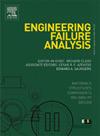Failure investigation of hybrid double-lap shear bolted connections with additively manufactured 316L stainless steel inner plates
IF 4.4
2区 工程技术
Q1 ENGINEERING, MECHANICAL
引用次数: 0
Abstract
The growing body of research on additive-manufactured components in structural engineering highlights the importance of assessing their potential, particularly in understanding how key manufacturing and design parameters influence performance. In this context, alongside conventional inner plates, this study investigates the failure behaviour of additive-manufactured inner plates of 316L stainless steel as hybrid component in double-lap shear bolted configurations. Two distinct printing methods were considered: wire arc additive manufacturing and selective laser melting. The study considered different surface conditions (as-built and machined) and extraction/print direction . By evaluating the actual failure mode and cracking behaviour, this study explores the influence of the manufacturing process and variations in geometrical design parameters, treated as key variables affecting the failure mechanism of the inner plates. The findings indicate that while the test coupons exhibited significant variations in stiffness and ductility, the failure behaviour of conventional and additively manufactured inner plates remained largely similar when accounting for surface condition and printing direction. Differences in load capacity across manufacturing methods were found to be limited when thickness was controlled. However, distinctly different crack propagation paths were observed in as-built wire arc additive-manufactured inner plates extracted at and , attributed to the effect of diagonal printing layers. These insights contribute to understanding overall connection integrity and highlight both the challenges and opportunities of integrating additive manufacturing into bolted connections.
增材制造316L不锈钢内板复合双搭接剪切螺栓连接失效研究
结构工程中对增材制造部件的研究越来越多,强调了评估其潜力的重要性,特别是在了解关键制造和设计参数如何影响性能方面。在这种情况下,除了传统的内板外,本研究还研究了添加制造的316L不锈钢内板作为混合组件在双搭接剪切螺栓配置中的破坏行为。考虑了两种不同的印刷方法:电弧增材制造和选择性激光熔化。该研究考虑了不同的表面条件(建造和加工)和提取/打印方向(θ=0°,45°,60°和90°)。通过评估实际的破坏模式和开裂行为,本研究探讨了制造工艺和几何设计参数变化的影响,将其作为影响内板破坏机制的关键变量。研究结果表明,虽然测试板在刚度和延展性上表现出显著的变化,但在考虑表面状况和印刷方向时,传统和增材制造的内板的破坏行为在很大程度上保持相似。当厚度被控制时,不同制造方法的负载能力差异被发现是有限的。然而,在θ=45°和60°处提取的增材制造内板中,由于对角印刷层的影响,裂纹扩展路径明显不同。这些见解有助于理解整体连接完整性,并突出了将增材制造集成到螺栓连接中的挑战和机遇。
本文章由计算机程序翻译,如有差异,请以英文原文为准。
求助全文
约1分钟内获得全文
求助全文
来源期刊

Engineering Failure Analysis
工程技术-材料科学:表征与测试
CiteScore
7.70
自引率
20.00%
发文量
956
审稿时长
47 days
期刊介绍:
Engineering Failure Analysis publishes research papers describing the analysis of engineering failures and related studies.
Papers relating to the structure, properties and behaviour of engineering materials are encouraged, particularly those which also involve the detailed application of materials parameters to problems in engineering structures, components and design. In addition to the area of materials engineering, the interacting fields of mechanical, manufacturing, aeronautical, civil, chemical, corrosion and design engineering are considered relevant. Activity should be directed at analysing engineering failures and carrying out research to help reduce the incidences of failures and to extend the operating horizons of engineering materials.
Emphasis is placed on the mechanical properties of materials and their behaviour when influenced by structure, process and environment. Metallic, polymeric, ceramic and natural materials are all included and the application of these materials to real engineering situations should be emphasised. The use of a case-study based approach is also encouraged.
Engineering Failure Analysis provides essential reference material and critical feedback into the design process thereby contributing to the prevention of engineering failures in the future. All submissions will be subject to peer review from leading experts in the field.
 求助内容:
求助内容: 应助结果提醒方式:
应助结果提醒方式:


